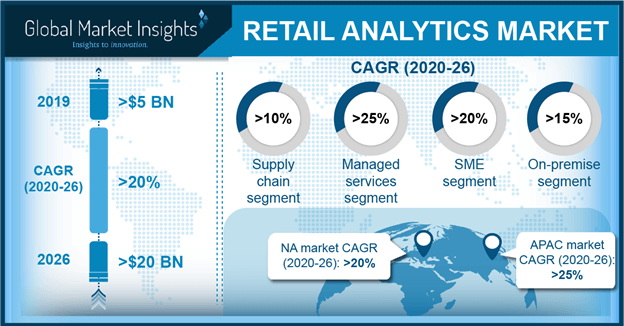Three trends prevalent in retail analytics market – enumerating the role of location analytics in the industry growth
Publisher : Fractovia | Published Date : 2017-09-28Request Sample
Retail analytics industry has been rapidly gaining momentum in recent times, subject to the escalating requirement of thorough insights to efficiently handle and forecast future performance. Retail analytics undoubtedly help suppliers to predict consumer needs, facilitating retailers to set appropriate costs for the right products at the right time, at the right location. In addition, data analytics help in effectively devising product pricing strategies and integrating the same in mainstream retailing operations, thereby increasing their demand and inherently providing a boost to the overall retail analytics industry. Applying retail analytics in coining pricing strategies has of late become the need of the hour, given the rise in the complexity witnessed across the retail industry.
U.S. Retail Analytics Market Size, By Function, 2016 & 2024 ($Mn)

Today, the retail domain has been experiencing drastic changes that have posed several challenges for retailers along the lines of fluctuations in the global economy, rise in the number of new product launches, threat of digital competition, and demanding consumers. In a bid to overcome these challenges and ensure accurate marketing & procurement decision-making, retailers have adopted retail analytics as a tool to capture information on inventory, supply chain activities, sales, and consumer demand, which would certainly set the wheels running for the retail analytics industry growth.
Suppliers have been trying to increase their go-to-market strategies to reach customers via myriad channels of communications such as social media, online advertisement, and emails. With massive increase in the external and internal information, most of these suppliers are considering the adoption of retail analytics to effectively handle unstructured information received through various sources such as third-party, social networking site and global entities. Encompassing a widespread application scope of customer engagement assessment, pricing & profitability management, supply chain management, and risk & fraud detection, retail analytics market is certain to chart out a lucrative growth path in the ensuing years.
Analyzing the trends across the retail analytics market
The latest buzzwords proliferating the retail space are big data analytics and business intelligence. Retailers across the globe have now begun to master the art of integrating smart data analytics with artificial intelligence to procure massive profits. With the rising competition and economic instability, retailers are adopting analytics as an effective tool to boost their performance and enhance consumer experience. As of today, retail analytics industry is remnant of the trends outlined below:
The deployment of location analytics to gauge consumer buying behavior
Retailers have lately been deploying the location centric data analytics process to accumulate bulk data and obtain a detailed perception regarding prominent consumer locations that would eventually help them track consumer purchase patterns and offer geo-targeted push notifications. Renowned retail stores such as Nordstrom have already adopted location analytics across their stores with a view to get an insight into the store visiting patterns of the consumers falling in the different age-groups, which would certainly provide a boost to the overall retail analytics market.
The connection between retail analytics market and IoT
The emergence of IoT has already had a tremendous influence on retail analytics industry. For instance, Wi-Fi sensors fitted in retail stores can now help stores obtain accurate data pertaining to consumer purchasing patterns through their Wi-Fi-enabled devices. This data can help analyze insights such as the number of repeat visits consumers may have made to the store, customer movement sequence in the store, and the time spent by the consumer in a specific store. The information collected through IoT is certain to be a tremendous help to retailers for gathering consumer insights and their changing preferences.
The influence of augmented and virtual reality on retail analytics market
The AR and VR technologies have now penetrated the retail space as well, and are likely to enhance consumer experience, helping them visualize the products in terms of their look & feel effect. With consumers enjoying the experience of viewing an all-dimensional angle of their products, the demand for analytics is certain to rise a few notches higher. The deployment of AR and VR will also support retailers in designing their store lay outs and product shelves for virtual products to attract more customers to their stores.
The ever-expanding e-commerce domain is likely to have a proportional impact on retail analytics market. Not to mention, the requirement to enhance the consumer shopping experience at the retail stores and the demand for data-centric business solutions is certainly expected to propel retail analytics industry expansion.
Reputed firms such as Adobe Systems, Teradata, IBM Corporation, Angoss Software Corporation, Tableau Software, and Oracle Corporation have made significant contributions to the retail analytics market in recent times. Global market Insights, Inc., forecasts retail analytics industry size to grow at a rate of nearly 19% over 2017-2024.